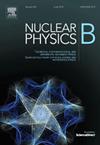Probing quantum criticality near the BTZ black hole horizon: Insights from coupled fermion-antifermion pairs
IF 2.5
3区 物理与天体物理
Q2 PHYSICS, PARTICLES & FIELDS
引用次数: 0
Abstract
In this study, we analytically examine the behavior of a fermion-antifermion () pair near the horizon of a static BTZ black hole using a fully covariant two-body Dirac equation with a position-dependent mass, . This formulation leads to a set of four first-order equations that can be reduced to a second-order wave equation, enabling the analysis of gravitational effects on quantum interactions. Two mass modifications are considered: (i) , representing an attractive Coulomb interaction, and (ii) , corresponding to a Cornell potential. For case (i), an exact analytical solution is obtained, while for case (ii), conditionally exact solutions involving biconfluent Heun functions are derived. For the lowest mode (), the results indicate that real oscillations without energy loss occur when in scenario (i) and in scenario (ii), suggesting stable oscillatory behavior. When in scenario (i) or in scenario (ii), the state exhibits decay, indicating instability below these critical thresholds. At (scenario (i)) and (scenario (ii)), the system reaches a state where its evolution ceases over time. These findings provide insights into the stability conditions of fermion-antifermion pairs near the black hole horizon and may have relevance for determining critical coupling strengths in systems such as holographic superconductors. Furthermore, this work adopts an effective semi-classical quantum gravity approach, offering a practical framework for incorporating gravitational effects. However, a more complete description of the system would require a deeper understanding of quantum gravity beyond computational methods. The results presented here may contribute to further studies exploring the influence of strong gravitational fields on quantum systems.
求助全文
约1分钟内获得全文
求助全文
来源期刊

Nuclear Physics B
物理-物理:粒子与场物理
CiteScore
5.50
自引率
7.10%
发文量
302
审稿时长
1 months
期刊介绍:
Nuclear Physics B focuses on the domain of high energy physics, quantum field theory, statistical systems, and mathematical physics, and includes four main sections: high energy physics - phenomenology, high energy physics - theory, high energy physics - experiment, and quantum field theory, statistical systems, and mathematical physics. The emphasis is on original research papers (Frontiers Articles or Full Length Articles), but Review Articles are also welcome.
 求助内容:
求助内容: 应助结果提醒方式:
应助结果提醒方式:


